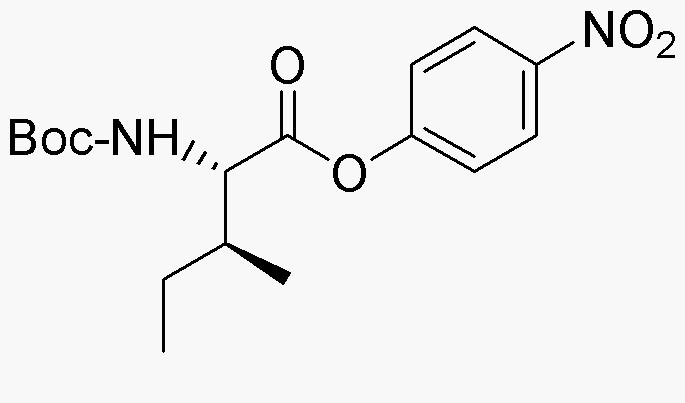Boc-L-isoleucine 4-nitrophenyl ester is widely utilized in research focused on:
- Peptide Synthesis: This compound serves as a valuable building block in the synthesis of peptides, allowing researchers to create complex structures with specific amino acid sequences.
- Drug Development: Its application in medicinal chemistry facilitates the design of novel pharmaceuticals, particularly in targeting specific biological pathways.
- Bioconjugation: The compound is used in bioconjugation processes, where it helps attach biomolecules to surfaces or other molecules, enhancing the efficacy of drug delivery systems.
- Research in Protein Engineering: It plays a crucial role in modifying proteins, aiding in the development of proteins with improved stability and functionality for various industrial applications.
- Analytical Chemistry: The compound is employed in analytical methods to study the properties of amino acids and peptides, providing insights into their behavior in different environments.
General Information
Properties
Safety and Regulations
Applications
Boc-L-isoleucine 4-nitrophenyl ester is widely utilized in research focused on:
- Peptide Synthesis: This compound serves as a valuable building block in the synthesis of peptides, allowing researchers to create complex structures with specific amino acid sequences.
- Drug Development: Its application in medicinal chemistry facilitates the design of novel pharmaceuticals, particularly in targeting specific biological pathways.
- Bioconjugation: The compound is used in bioconjugation processes, where it helps attach biomolecules to surfaces or other molecules, enhancing the efficacy of drug delivery systems.
- Research in Protein Engineering: It plays a crucial role in modifying proteins, aiding in the development of proteins with improved stability and functionality for various industrial applications.
- Analytical Chemistry: The compound is employed in analytical methods to study the properties of amino acids and peptides, providing insights into their behavior in different environments.
Documents
Safety Data Sheets (SDS)
The SDS provides comprehensive safety information on handling, storage, and disposal of the product.
Product Specification (PS)
The PS provides a comprehensive breakdown of the product’s properties, including chemical composition, physical state, purity, and storage requirements. It also details acceptable quality ranges and the product's intended applications.
Certificates of Analysis (COA)
Search for Certificates of Analysis (COA) by entering the products Lot Number. Lot and Batch Numbers can be found on a product’s label following the words ‘Lot’ or ‘Batch’.
*Catalog Number
*Lot Number
Certificates Of Origin (COO)
This COO confirms the country where the product was manufactured, and also details the materials and components used in it and whether it is derived from natural, synthetic, or other specific sources. This certificate may be required for customs, trade, and regulatory compliance.
*Catalog Number
*Lot Number
Safety Data Sheets (SDS)
The SDS provides comprehensive safety information on handling, storage, and disposal of the product.
DownloadProduct Specification (PS)
The PS provides a comprehensive breakdown of the product’s properties, including chemical composition, physical state, purity, and storage requirements. It also details acceptable quality ranges and the product's intended applications.
DownloadCertificates of Analysis (COA)
Search for Certificates of Analysis (COA) by entering the products Lot Number. Lot and Batch Numbers can be found on a product’s label following the words ‘Lot’ or ‘Batch’.
*Catalog Number
*Lot Number
Certificates Of Origin (COO)
This COO confirms the country where the product was manufactured, and also details the materials and components used in it and whether it is derived from natural, synthetic, or other specific sources. This certificate may be required for customs, trade, and regulatory compliance.


